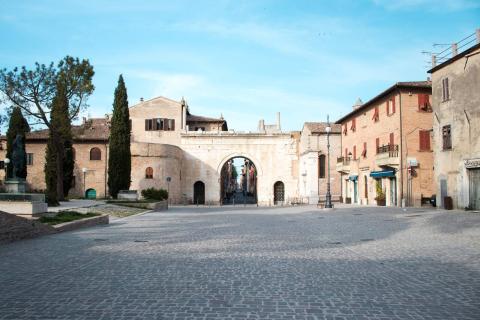Anyone visiting Fano for the first time cannot help but notice its ancient origins, thanks to the many artifacts dating back to Roman times scattered throughout the city.
From the Arch of Augustus, one of the most important historic buildings in all the Marches, passing through the remains of the walls, still intact for long stretches, up to the grid of streets in the Centre, and the various kinds of finds exhibited in different parts of the city, Fano is the ideal destination for lovers of history and ancient finds.
Its Roman origins are undoubtedly one of the levers that most attracts tourists, not only for their inestimable historical value, but also for an indisputable aesthetic value that gives the city a charm of other times.
A story that starts from afar, with illustrious and prestigious testimonies.
Le origini romane di Fano
The first written testimony of the city of Fano, formerly called Fanum Fortunae, dates back to 49 BC, when Caesar installed a Cohort there. The ancient name derives from the Temple built there dedicated to the Goddess of Fortune which, in all probability, was erected after the victory of the famous Battle of Metauro in which the Romans defeated Hasdrubal in 207 BC.
The fortune of what was initially only a small hub was precisely its centrality on the road that connected Rome to Gallia Cispadana, the current Emilia Romagna.
Under the Empire of Caesar Octavian Augustus, Fano developed further assuming the status of a Roman colony: Colonia Iulia Fanestris. The construction of the walls still visible today dates back to this period.
The city then remained under the Ancient Roman Empire until its fall. The city retains many monuments from that era, evidence of an ancient past.
I più bei monumenti di epoca romana
To admire the beauty of the historical finds from the Roman era, just stroll through the streets of the historic center where, a few hundred meters away from each other, it is possible to come across the following places of interest, which we have talked about in more in depth in the article dedicated to places to visit in Fano:
Pincio and Arch of Augustus
Mura Augustee
Porta della Mandria
Church of San Michele
Fano Underground
Walking through the streets of the city it is evident that it was designed according to the canons of the building programs of the Augustan era, with a structure of the streets typical of Roman cities, complete with theaters and amphitheatres. Even the sewage system and the water supply system of the city of the time are still well preserved.
Fano Città di Vitruvio
Marco Vitruvio Pollone, author of the famous De Architectura, is considered the most important architectural theorist in history. His work was one of the pillars on which this art was based until the end of the 19th century.
Although his treatise and the figure of him are to all intents and purposes the backbone of architectural sciences, Vitruvius recognized that he had only designed a single building in his entire life: the Basilica of Fano.
Its exact location still remains uncertain, but the Roman theorist expressly mentions it in his work, precisely in the fifth of the ten volumes that make up the treatise, speaking of his direct involvement in the construction and design of this place of worship.
Although we have neither images nor, to date, remains that can be attributed with certainty to its construction, thanks to the description of the building in De Architectura it has been possible to reconstruct some of its characteristics.
The Basilica was probably built on the city's Forum, with the main facade on the long side and an area inside dedicated to the cult of Augustus, the aedes augusti. The historical surveys made up to now, hypothesize its destruction around 635 at the hands of the Goths.
The testimony of this building is undoubtedly a symbol of the importance of the city in the Empire of the time and gives further prestige to the history of Fano, being the only place where it is certain that Vitruvius built a building designed by him .
Come visitare queste attrazioni
As for the Vitruvian Basilica, from the entrance of the current Church of Sant'Agostino it is possible to access the archaeological area with what is supposed to be the remains of the building.
The Pincio, the Arch of Augustus, the Walls and the Porta della Mandria are on public land and can therefore always be visited.
For information, contact the Call & Go number +39 366 3426985 active from 9 to 23.00
